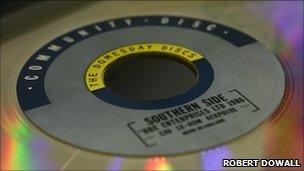Relive the BBC Domesday project at Bletchley Park
- Published

The laser disc technology became obsolete within 15 years
Original contributors to the BBC's Domesday project can now see their work as it was first displayed.
The National Museum of Computing at Bletchley Park still has two working computer systems that were originally used for the 1986 project.
The public can use the 1980s laser disc technology at the museum to see the complete archive.
To celebrate the project's 25th anniversary, the BBC has also published the archive online.
Domesday was an initiative, run by the BBC, Acorn Computers, Philips and Logica aiming to create a record of life in Britain in the 1980s.
More than one million people participated in recording what they thought might be of interest in 1000 years' time. The focus was on everyday life, the ordinary rather than the extraordinary.
Schools and community groups were particularly active and contributed almost 150,000 pages of text and more than 23,000 photographs to the community disc.
However, within 15 years, the discs that the information was stored on and the BBC Master Micro, the computer used to play them, had become obsolete.
As a result, not many of the original contributors have ever seen their work.
Growing interest
Chris Monk, the museum's education officer explained how the system was eventually overtaken by cheaper technology.
"When Domesday was originally launched, its key technology - the LV-ROM (LaserVision ROM) - was state of the art multimedia," he said.
"With the ability to store up to 324MB of digital data on each side as well as 54,000 analogue video frames and offering interactivity, the technology seemed to have enormous potential.
"But LV-ROM players were expensive and the format never really caught on, soon being overtaken by the cheaper Compact Disc ROM (CD-ROM). As a result, not many contributors saw the fruits of their labours."
The National Museum of Computing houses the largest collection of functional historic computers in Europe and Mr Monk revealed that he had seen a growing interest in Domesday since he made this original functioning 1980s system available to visitors in September 2010.
"Visitors to the Museum often tell me that they contributed to the project over 25 years ago, but never had the opportunity to see their work," he explained.
"Now they can - on the original laser disc and Acorn BBC Master micro technology, as well as on the BBC website. They can experience the project exactly the way it was originally envisaged."
Mr Monk explained how visitors search for their 1980s location to see how things have changed and are often surprised by the results.
"They spot that new road, a missing factory or some new houses," he said.
"Others spot the changing fashions and the rather dated cars, but there is not a mobile phone to be seen.
"One visitor even saw a much younger version of himself and another found the words he had written as a primary school child. He was delighted when we printed out his text on a 1980's dot matrix printer!"
The BBC has also reloaded the Domesday Community Disc online and is inviting the public to explore and update the 1980's community-sourced photographs on Domesday Reloaded.
- Published16 May 2011